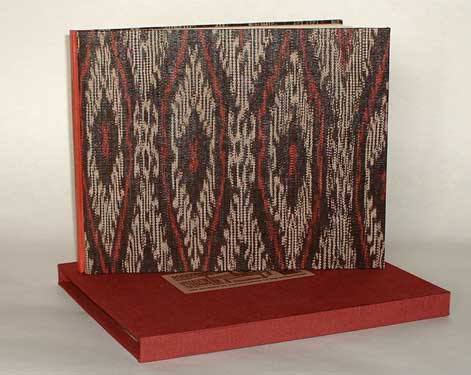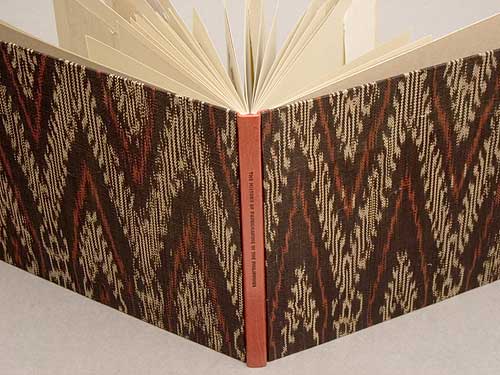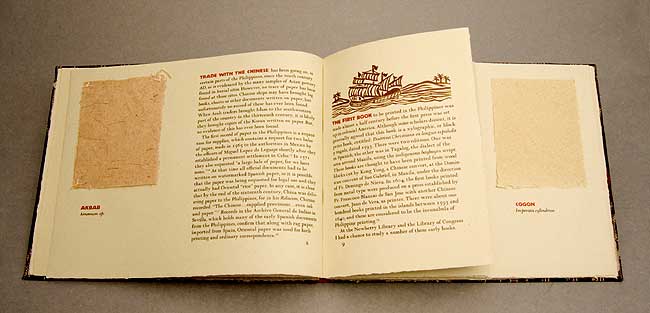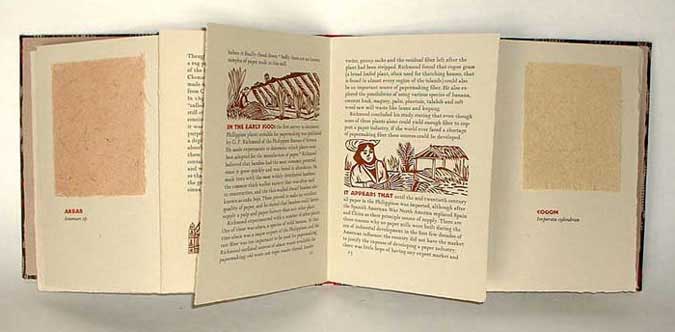PETER & DONNA THOMAS
![]() 260 Fifteenth Avenue Santa Cruz CA 95062 (831)
475-1455
260 Fifteenth Avenue Santa Cruz CA 95062 (831)
475-1455
PETER & DONNA THOMAS
![]() 260 Fifteenth Avenue Santa Cruz CA 95062 (831)
475-1455
260 Fifteenth Avenue Santa Cruz CA 95062 (831)
475-1455
The History of Papermaking in the Philippines. (2005) Written by Peter Thomas. Illustrated by Donna Thomas with 15 linoleum cuts. Handbound by Peter and Donna Thomas. Letterpress printed on a text paper handmade by Peter Thomas. Includes eleven paper samples handmade by Filipinos from Philippine plants.
Seventy-five copies of this book have been handset, letterpress
printed on Peter’s handmade paper and hand bound by Peter and Donna
Thomas. The book measures 10 3/4 by 13 5/8 inches and has fifty pages. It
is quarter bound with a red Moroccan leather spine (blind stamped with the
title) and the boards are covered with T’nalak (a Philippine ikat dyed
fabric, made with twisted abaca fiber, woven on a backstrap loom). The edition
has seventy regular copies, in slipcases.
There are 5
special copies, housed in a clam-shell box, with the same binding and a suite
of hand colored linoleum prints, illustrations from the book.
One special copy contains all the rough drafts,
artist’s sketches and author’s research documents.
The History of Papermaking in the Philippines is the culmination of almost twenty years of work. Making this book could be likened to walking in the footsteps of Dard Hunter; or, in a less romantic but perhaps more accurate way to completing a doctoral dissertation. The book had its genesis in 1986 when Nida Dumsang, visiting from the Philippines, taught a one day papermaking workshop in Santa Cruz. Peter took the class, learning how to make paper from plants, a thing he had not done before. We bought samples of Dumsang’s paper with the thought of making a book to feature the papers that would be accompanied by a short text describing her processes and also a brief history of papermaking in the Philippines.
This was easier said than done, for we could’t find any references to Philippine papermaking in any local libraries, the Dard Hunter Paper Museum or the Library of Congress. When we asked Dumsang for information on the subject, she wrote back: "The Philippines had no tradition of written history before the arrival of the white man...historians have found it difficult to piece together facts because there are only the scantiest written records from that era."
Peter was astonished that there was not a history of papermaking in the Philippines; with such variety and abundance of fibrous plants, suitable for papermaking, it seemed likely that Filipinos would have used those plants to make paper. The idea of writing the first history of Filipino papermaking called him, and Peter entered into the project with the zeal of a second Dard Hunter. But it soon became clear he could not do justice to the subject without visiting the country and in February of 1990 he went to the Philippines. Later that year we made a book, Bayad - The story of a trip to the Philippines to discover why there is no history of papermaking in that country, which chronicles the trip. But the research had just started. It took years, following up the leads he found on that trip, to get all the information needed to complete the text.
This present book presents the information that was gathered over the following ten years (with the help and encouragement of numerous scholars and colleagues). The text includes discussions of the pre-historic precursors to paper, including Philippine bark cloth. It contains a survey of the first printed books made in the Philippines and the paper they were printed on. (The first book printed in the Philippines was made before a book was printed in the New England colonies.) It documents our research to discover when the first sheet of paper was made in the Philippines. When describing abaca fiber the text describes how it made Manila hemp rope, and how that was used to make Manila paper. The book ends with a chronological history of both commercial and hand paper making in the Philippines up to 2000.
The History of Papermaking in the Philippines was designed, letterpress printed and handbound by Peter and Donna Thomas on paper that they made. Peter wrote the text and Donna cut the block print illustrations. The text and illustrations were printed in three colors on a Vandercook Universal One proof press. The text was hand set using 18 pt Goudy Modern (often rewriting the text to improve the appearance of the page and line ends) and the titles were hand set using Neuland types. The notes and appendices were set monotype by Rich Hopkins using Pat Taylor's unique English monotype mats. The text paper was handmade made by Peter Thomas from cotton rag, pigmented with umber and flecked with Timkin (a Philippine fiber). The sample papers were made from Philippine plants, in the Philippines, by various Filipino papermakers. The binding structure was developed by Peter and Donna to accommodate the special requirements of this book: the short and long pages create space for the paper samples and the samples are sewn in place so that they can move with changes in humidity. The binding has a red Morocco leather spine, blind stamped with the title, and the boards are covered with T'nalak (a Philippine ikat dyed fabric, made with spun abaca fiber, woven on a backstrap loom). Each book is housed in a red cloth-covered slipcase with the title and an illustration inset on the front. The book is in landscape format and measures 10 3/4 by 13 5/8 inches and has 50 pages. There are 75 copies, 70 available at $950 There are five special copies, with the same binding but housed in a clamshell box and accompanied by a suite of prints from the book available at $1950 and one of the special copies comes additionally with all the rough drafts, artists sketches and all research documents and is available at $2950.




